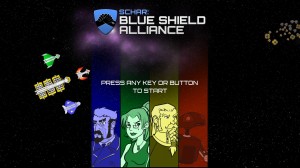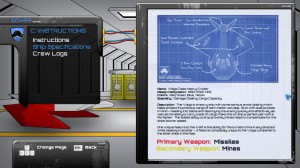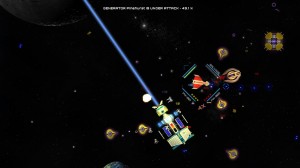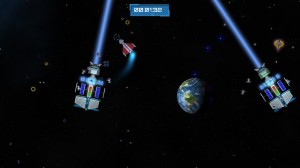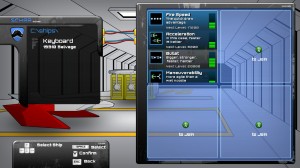How many of you remember Asteroids for the Atari 2600? *Sigh*…okay, imagine if you can, being limited to a controller with one button on it. You pointed your ship (triangle) in a direction and thrust, then rotated on your axis and spammed the fire button. “SCHAR: Blue Shield Alliance” is a twin stick shooter that takes that concept one step further and allows you to move freely while firing in the direction you are pointing. You can thrust left or right (strafing) in addition to moving forward and back, depending on where your cursor is located (if you’re using a keyboard). Before we start getting into specifics, I wanted to thank Nick Puleo for setting me up with a free review copy of the game.
“SCHAR: Blue Shield Alliance” is an arcade game through and through, sporting an impressive four player local cooperative element that will keep the adrenaline of you and your friends pumping. The main menu will allow you to start or continue a game, try survival modes, view a codex, and change game settings. Freeplay allows you to replay levels that you’ve already beaten, and thus won’t be available right from the start. Your options menu addresses your basics like fullscreen / windowed mode, sound, music, volume, anti-aliasing, and screen resolution. I particularly found the codex helpful as it not only provides a copy of the manual inside the game, but outlines the specs of the ships you’ll have access to. For some reason, viewing keyboard controls are only possible while actually participating in a game, but it’s a minor inconvenience.
You and your couch friends will be able to choose between four different kinds of ships, each with their own unique abilities. The Euphrates is a good, all around ship that is well-balanced and suitable for solo play. It features a primary laser cannon and a limited supply of both heat seeking missiles that pack a powerful punch and turrets that stay on the battlefield for a limited time. The Rio is fast but has the least amount of cargo space for salvage, and it slows to a crawl when its hold is full. In addition to a single laser cannon and a limited supply of heat seeking missiles, it can drop heal bots that repair allied ships. The Volga is slow but sturdy and able to hold a lot more cargo. It has two laser cannons instead of one AND can fire them in any direction regardless of where its front is pointed. Like the other two ships, it has heat seeking missiles but has the ability to drop proximity mines. Finally, the Potomac is an armed transport that sports a single laser cannon, proximity mines, and turrets. It holds the most cargo out of all of them but is by far the least maneuverable. The ships are varied and after a while, you’re guaranteed to find one suitable to your play style.
To sum up gameplay, you’ll be protecting one or more shield generators that orbit a celestial body (the Earth, its moon, etc.) from waves of enemy ships. As you destroy ships, they drop salvage. Flying close to salvage will attract it to your ship, which you’ll then carry to the shield generator to increase its health and score you points. You’ll want to bring as much salvage as you can to your shield generator not only to keep it alive, but to keep your score multiplier up to its maximum value. Each ship is equipped with a limited supply of special weapons, so they should be used sparingly. If the armor value of your ship reaches zero, your pilot will eject and you can guide him/her to a shield generator for a new ship. An ally can revive you as well, if you have a friend or two playing co-op. Players can keep track of ship locations, their salvage space, their armor / health, the number of special weapons they have left, and etc. by utilizing their ship’s radar.
In between levels, you can upgrade your ships by spending the salvage you’ve collected. This will transform your ship from being a slow, weak pea shooter and turn it into a formidable force. You’ll be able to increase the effectiveness of your armor, weapons, maneuverability, top speed, fire rate, and more. The ability to pick and choose your upgrades becomes the most helpful when playing with friends, as you’ll be able to specialize your ships into particular roles. You may want your friend to increase their hold space while you focus on being the primary enemy killer, for example.
Personally, I enjoyed my time with “SCHAR: Blue Shield Alliance”. While the local co-op is fun, it is my hope that one day the designers are able to implement LAN and IP cooperative modes. Steam would be an excellent platform to support this (should the game get the Greenlight thumbs up) as it utilizes an invite feature. Still, it’s a fun (and cheap) way to game away the weekend with a group of friends. “SCHAR: Blue Shield Alliance” is certainly worth its current price tag (as of 11/10/12) of $2.49 on Desura and then some. For a buck more, you can grab the soundtrack, the game’s concept art, and a printable PDF manual. If you’re in the mood for some casual, space shoot-em-ups and have a group of friends over, then “SCHAR: Blue Shield Alliance” will do nicely.
Final Verdict: 7/10
—
You can learn more about SCHAR Blue Shield Alliance by visiting the following website:
http://www.blueshieldalliance.com
You can try the demo, here:
You can help bring this game to Steam by voting for it on its Greenlight page here:
http://steamcommunity.com/sharedfiles/filedetails/?id=94075491
You can find the game on Desura here:
http://www.desura.com/games/schar-blue-shield-alliance
You can check out play sessions here:
http://www.youtube.com/watch?v=KqguwoWl-JQ

